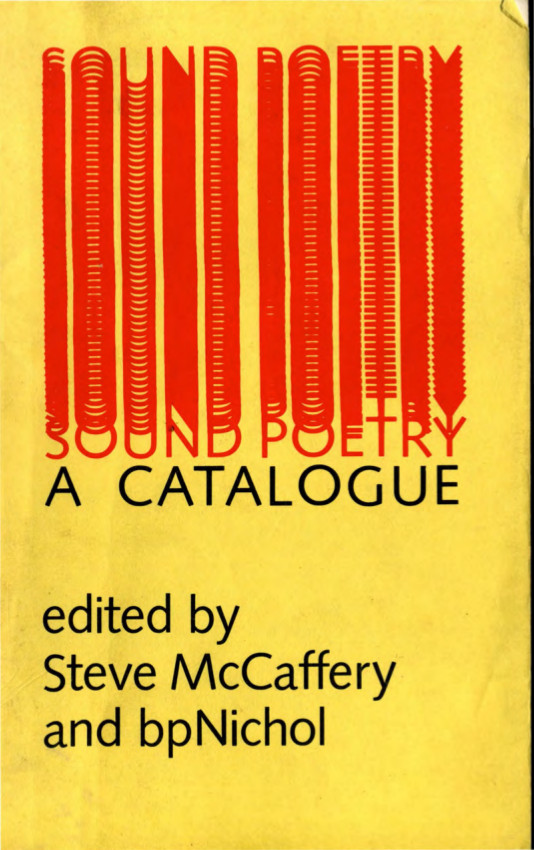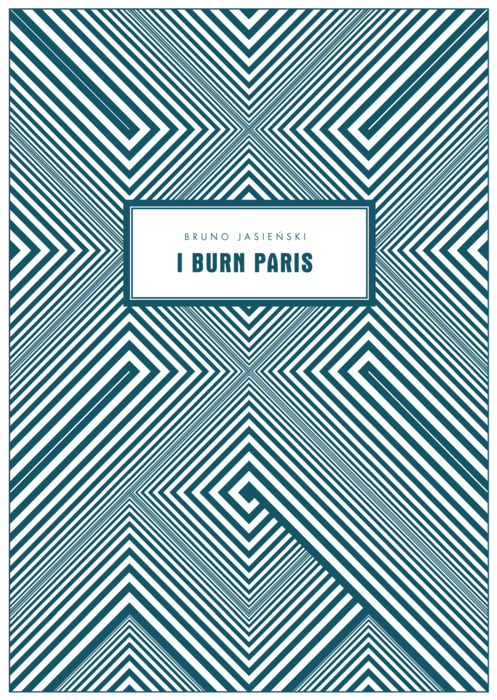Steve McCaffery, bpNichol (eds.): Sound Poetry: A Catalogue (1978)
Filed under catalogue, poetry | Tags: · dada, futurism, lettrism, poetry, sound poetry, voice

For the Eleventh International Sound Poetry Festival in Toronto, Canada, October 1978.
With texts and works by Steve McCaffery, Paula Claire, Greta Monach, Charlie Morrow, Jackson Maclow, Bob Cobbing, Bernard Heidsieck, Paul Dutton, Sten Hanson, Henri Chopin, R. Murray Schafer, Owen Sound, Jerome Rothenberg, Michael Gibbs, Raoul Duguay, Steve Ruppenthal, Earle Birney, Lawrence Upton, Dick Higgins, Sean O’Huigin, Ann Southam, Arrigo Lora-Totino, Larry Wendt, bpNichol, Cris Cheek, P.C. Fencott, Ilmar Laaban, Lars-Gunnar Bodin, Bill Griffiths and Ake Hodell.
Publisher Underwhich Editions, Toronto, 1978
112 pages
via Juan Angel Italiano
Extra information and resources related to the catalogue (via Danny Snelson, added on 2014-1-20)
PDF
McCaffery’s introduction on UbuWeb
Vasily Kamensky: Tango With Cows: Ferro-Concrete Poems (1914) [Russian]
Filed under artist publishing | Tags: · concrete poetry, cubo-futurism, futurism, poetry, typography, visual poetry
Tango With Cows is an artists’ book by the Russian futurist poet Vasily Kamensky, with three drawings by the brothers David and Vladimir Burliuk. Printed in an edition of 300, the work has become famous primarily for being made entirely of commercially produced wallpaper, with a series of concrete poems – visual poems that employ unusual typographic layouts for expressive effect – printed onto the recto of each page.
Beginning with a drawing by Vladimir Burliuk of a woman, the poems are split into two sections; the first contains 8 concrete poems that use multiple fonts and unusual spacings to express sounds and textures. Telephone, for instance, starts with ‘Telephone No. 2B_128 / rgrgrrrrrr______rrg’. The second group of 6 are arranged within diagonal grids, that evoke both the cubist paintings of Picasso and Braque, and the moulds that are used to make reinforced concrete. These poems refer directly to aerial views, maps and floor-plans. (from Wikipedia)
Tango s korovami: zhelezobetonnye poemy [Танго С Коровами: Железобетонныя Поэмы]
Published in Moscow, 1914
36 pages
via Archive.org
PDF
PDF (single-page PDF of a volume bound in a slightly different order)
Eduardo Kac’s translation of the poem “Telephone”
TangoWithCows.com, a project to translate the book into English (forthcoming mid-2014)
Bruno Jasieński: I Burn Paris (1928–) [PL, EN, ES]
Filed under fiction | Tags: · avant-garde, catastrophe, communism, futurism, marxism

I Burn Paris has remained one of Poland’s most uncomfortable masterstrokes of literature since its initial and controversial serialization by Henri Barbusse in 1928 in L’Humanité (for which Jasieński was deported for disseminating subversive literature). It tells the story of a disgruntled factory worker who, finding himself on the streets, takes the opportunity to poison Paris’s water supply. With the deaths piling up, we encounter Chinese communists, rabbis, disillusioned scientists, embittered Russian émigrés, French communards and royalists, American millionaires and a host of others as the city sections off into ethnic enclaves and everyone plots their route of escape. At the heart of the cosmopolitan city is a deep-rooted xenophobia and hatred — the one thread that binds all these groups together. As Paris is brought to ruin, Jasienski issues a rallying cry to the downtrodden of the world, mixing strains of “The Internationale” with a broadcast of popular music.
With its montage strategies reminiscent of early avant-garde cinema and fist-to-the-gut metaphors, I Burn Paris has lost none of its vitality and vigor. Ruthlessly dissecting various utopian fantasies, Jasienski is out to disorient, and he has a seemingly limitless ability to transform the Parisian landscape into the product of disease-addled minds. An exquisite example of literary Futurism and Catastrophism, the novel presents a filthy, degenerated world where factories and machines have replaced the human and economic relationships have turned just about everyone into a prostitute. Yet rather than cliché and simplistic propaganda, there is an immediacy to the writing, and the modern metropolis is starkly depicted as only superficially cosmopolitan, as hostile and animalistic at its core.
This English translation of I Burn Paris fills a major gap in the availability of works from the interwar Polish avant-garde, an artistic phenomenon receiving growing attention with recent publications such as Caviar and Ashes.
First serialized in French as “Je brûle Paris” in L’Humanité in 1928.
Polish edition
Publisher Towarzystwo Wydawnicze “Rój”, Warsaw, 1929
English edition
Translated by Soren A. Gauger and Marcin Piekoszewski
With an Afterword by Soren Gauger
Publisher Twisted Spoon Press, Prague, 2012
ISBN 9788086264370
309 pages
Review (Benjamin Noys, Mute)
Review (M.A.Orthofer, The Complete Review)
Review (Isla Badenoch, Article Magazine)
Commentary (Nina Kolesnikoff, 1982)
Wikipedia (in Polish)
Publisher (EN)
Google books (EN)
Palę Paryż (Polish, 1929, HTML), Alt link
I Burn Paris (English, 2012, EPUB, removed on 2015-1-15 upon request of the publisher)
Anatol Stern’s 1957 preface (Polish), English translation (Issuu.com)
Voy a meterle fuego a París (Spanish, trans. Jorge Segovia and Violetta Beck, 2013, added on 2014-2-2)


